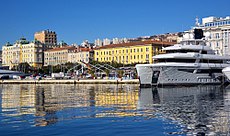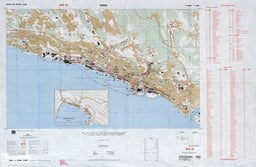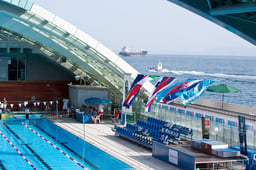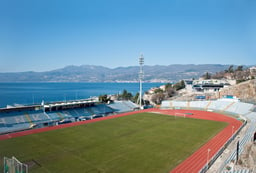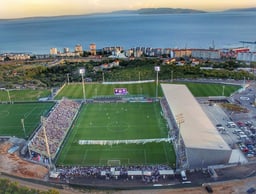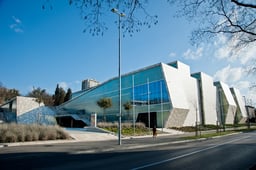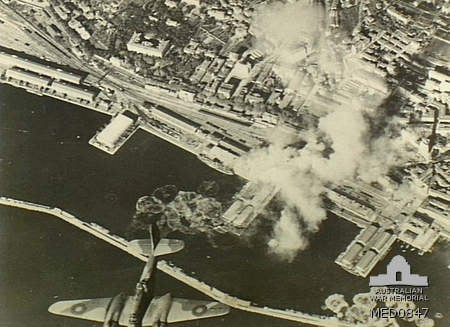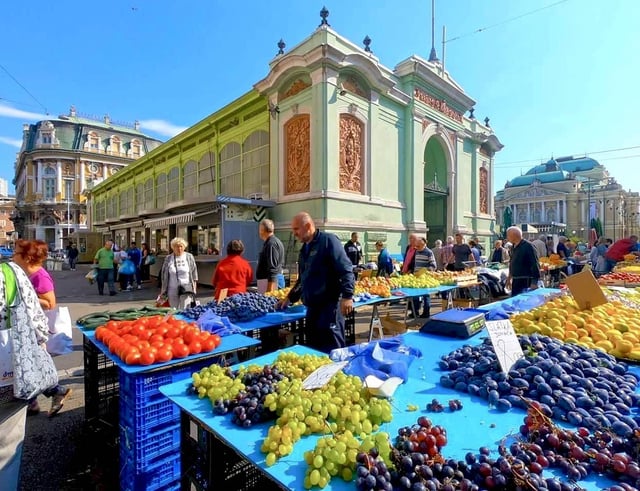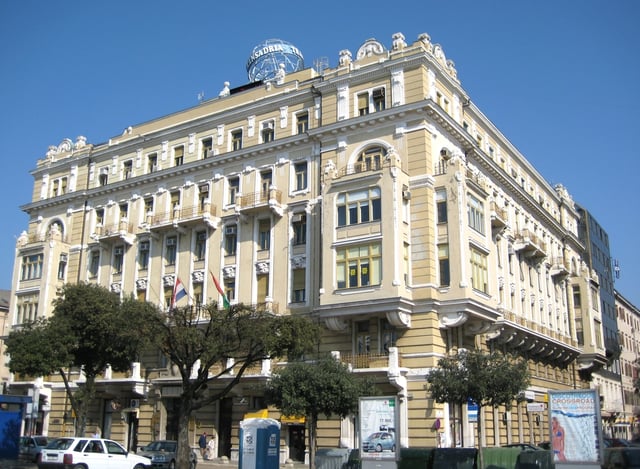Rijeka

Rijeka

Rijeka | |
|---|---|
City | |
| Grad Rijeka City of Rijeka | |
Rijeka | |
| Coordinates:45°19′37.434″N 14°26′31.834″E [62] | |
| Country | |
| County | |
| Government | |
| • Mayor | Vojko Obersnel (SDP) |
| • City Council | 35 members
|
| Area | |
| • City | 44 km2(17 sq mi) |
| • Urban | 825 km2(319 sq mi) |
| • Metro | 3,200 km2(843 sq mi) |
| Elevation | 0–499 m (0 – 1,561 ft) |
| Population (2019)[1] | |
| • City | 128,624 |
| • Metro | 360.000 |
| "Urbana aglomeracija Rijeka" | |
| Demonym(s) | Riječanka (female) Riječanin (male) |
| Time zone | UTC+1 (CET) |
| • Summer (DST) | UTC+2 (CEST) |
| Postal code | 51000 |
| Area code(s) | 051 |
| Vehicle registration | RI |
| Patron saints | St. Vitus |
| Website | www.rijeka.hr/en/ [63] |
Rijeka (/riˈɛkə, riˈeɪkə/, also US: /riˈjɛkə/,[2][3] Croatian: [rijěːka] (listen); Italian: Fiume [ˈfjuːme]; Slovene: Reka; German: Sankt Veit am Flaum) is the principal seaport and the third-largest city in Croatia (after Zagreb and Split). It is located in Primorje-Gorski Kotar County on Kvarner Bay, an inlet of the Adriatic Sea and has a population of 128,624 inhabitants.[1] Historically, because of its strategic position and its excellent deep-water port, the city was fiercely contested, especially among Italy, Hungary (serving as the Kingdom of Hungary's largest and most important port), and Croatia, changing hands and demographics many times over centuries. According to the 2011 census data, the majority of its citizens are Croats, along with a large minority of Serbs, and smaller numbers of Bosniaks and Italians.
Rijeka is the main city and county seat of the Primorje-Gorski Kotar County. The city's economy largely depends on shipbuilding (shipyards "3. Maj" and "Viktor Lenac Shipyard") and maritime transport. Rijeka hosts the Croatian National Theatre Ivan pl. Zajc, first built in 1765, as well as the University of Rijeka, founded in 1973 but with roots dating back to 1632 School of Theology.[4]
Apart from Croatian and Italian, linguistically the city is home to its own unique dialect of the Venetian language, Fiuman, with an estimated 20,000 speakers among the autochthonous Italians, Croats and other minorities. Historically Fiuman served as the main lingua franca between the many ethnicities inhabiting the multiethnic port-town. In certain suburbs of the modern extended municipality the autochthonous population still speaks the Chakavian tongue, a dialect of the Croatian language.
In 2016, Rijeka was selected as the European Capital of Culture for 2020, alongside Galway, Republic of Ireland.[5]
Rijeka | |
|---|---|
City | |
| Grad Rijeka City of Rijeka | |
Rijeka | |
| Coordinates:45°19′37.434″N 14°26′31.834″E [62] | |
| Country | |
| County | |
| Government | |
| • Mayor | Vojko Obersnel (SDP) |
| • City Council | 35 members
|
| Area | |
| • City | 44 km2(17 sq mi) |
| • Urban | 825 km2(319 sq mi) |
| • Metro | 3,200 km2(843 sq mi) |
| Elevation | 0–499 m (0 – 1,561 ft) |
| Population (2019)[1] | |
| • City | 128,624 |
| • Metro | 360.000 |
| "Urbana aglomeracija Rijeka" | |
| Demonym(s) | Riječanka (female) Riječanin (male) |
| Time zone | UTC+1 (CET) |
| • Summer (DST) | UTC+2 (CEST) |
| Postal code | 51000 |
| Area code(s) | 051 |
| Vehicle registration | RI |
| Patron saints | St. Vitus |
| Website | www.rijeka.hr/en/ [63] |
Name
Historically, Rijeka was also called Tharsatica, Vitopolis (lit. City of [Saint] Vito), or Flumen (lit. River) in Latin. The city is called Rijeka in Croatian, Reka in Slovene, and Reka or Rika in the local dialects of the Chakavian language. It is called Fiume ([ˈfjuːme]) in Italian. All these names mean "river" in their respective languages.[6][7] Meanwhile, Hungarian has adopted the Italian name while in German the city has been called Sankt Veit am Flaum—St Vito on the river Flaum—or Pflaum ([pflaʊm]).
Geography
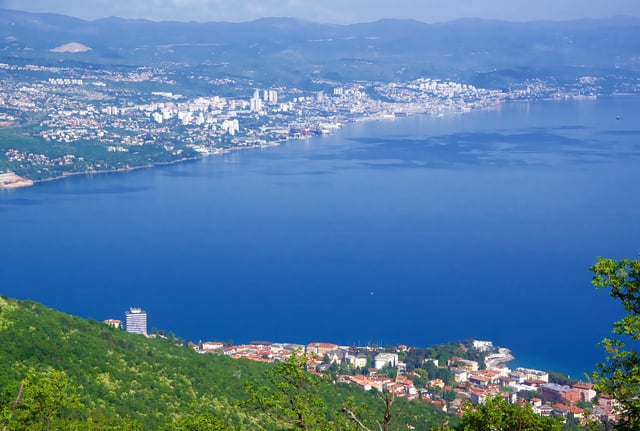
Rijeka Bay
Rijeka is located in western Croatia, 131 kilometres (81 miles) southwest of the capital, Zagreb, on the coast of Kvarner Gulf (45°21′N 14°26′E [64] ), in the northern part of the Adriatic Sea. Geographically, Rijeka is roughly equidistant from Milan (485 kilometres (301 miles)), Budapest (502 kilometres (312 miles)), Münich (516 kilometres (321 miles)), Vienna (516 kilometres (321 miles)) and Belgrade (550 kilometres (340 miles)). The Bay of Rijeka, which is bordered by Vela Vrata (between Istria and the island of Cres), Srednja Vrata (between Cres and Krk Island) and Mala Vrata (between Krk and the mainland) is connected to the Kvarner Gulf and is deep enough (about fifty metres or 160 feet) to accommodate large commercial ships. The City of Rijeka lies at the mouth of river Rječina and in the Vinodol micro-region of the Croatian coast. Two important land transport routes start in Rijeka due to its location. The first route is to the Pannonian Basin given that Rijeka is located alongside the narrowest point of the Dinaric Alps (about fifty kilometres or 31 miles). The other route, across Postojna Gate connects Rijeka with Slovenia, Italy and beyond.
History
Ancient and Medieval times
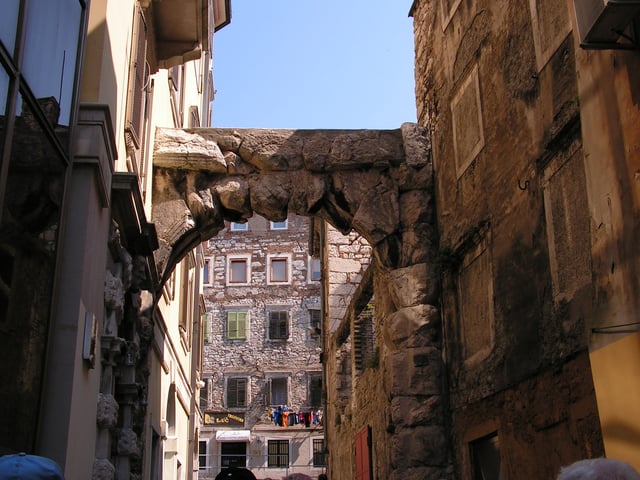
The Roman arch (Rimski luk), the oldest architectural monument in Rijeka and an entrance to the old town
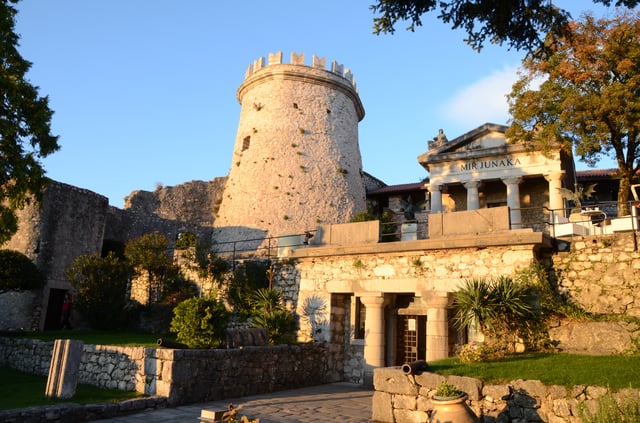
Trsat Castle lies at the exact spot of an ancient Illyrian and Roman fortress.
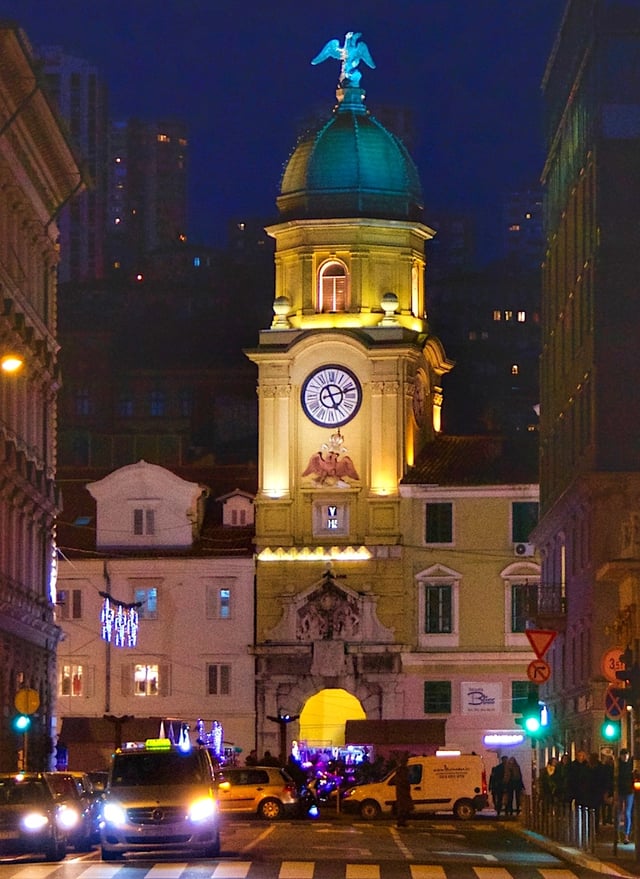
The Baroque city clock tower above the arched gateway linking the Korzo to the inner city, designed by Filbert Bazarig in 1876
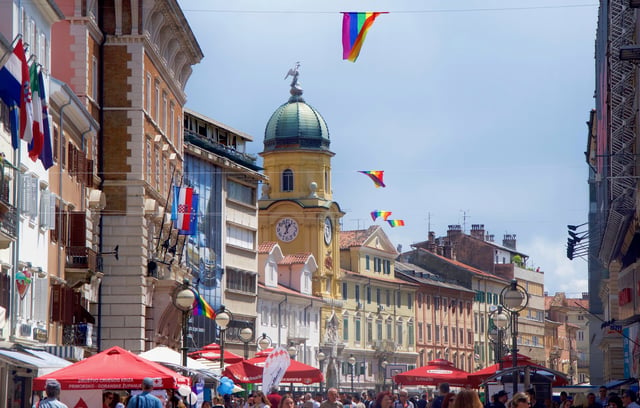
Main street Korzo
Though traces of Neolithic settlements can be found in the region, the earliest modern settlements on the site were Celtic Tharsatica (modern Trsat, now part of Rijeka) on the hill, and the tribe of mariners, the Liburni, in the natural harbour below. The city long retained its dual character. Rijeka was first mentioned in the 1st century AD by Pliny the Elder as Tarsatica in his Natural History (iii.140).[8]
In the time of Augustus, the Romans rebuilt Tharsatica as a municipium Flumen (MacMullen 2000), situated on the right bank of small river Rječina (whose name means "the big river"). It became a city within the Roman Province of Dalmatia until the 6th century.
After the 4th century Rijeka was rededicated to St. Vitus, the city's patron saint, as Terra Fluminis sancti Sancti Viti or in German Sankt Veit am Pflaum. From the 5th century onwards, the town was ruled successively by the Ostrogoths, the Byzantines, the Lombards, and the Avars. Croats settled the city starting in the 7th century giving it the Croatian name, Rika svetoga Vida ("the river of St. Vitus"). At the time, Rijeka was a feudal stronghold surrounded by a wall. At the center of the city, its highest point, was a fortress.
In 799 Rijeka was attacked by the Frankish troops of Charlemagne. Their Siege of Trsat was at first repulsed, during which the Frankish commander Duke Eric of Friuli was killed. However, the Frankish forces finally occupied and devastated the castle, while the Duchy of Croatia passed under the overlordship of the Carolingian Empire. From about 925, the town was part of the Kingdom of Croatia, from 1102 in personal union with Hungary. Trsat Castle and the town was rebuilt under the rule of the House of Frankopan. In 1288 the Rijeka citizens signed the Law codex of Vinodol, one of the oldest codes of law in Europe.
Rijeka even rivalled with Venice when it was purchased by the Habsburg emperor Frederick III, Archduke of Austria in 1466. It would remain under Habsburg overlordship for over 450 years, except for French rule between 1805 and 1813, until its occupation by Croatian and subsequently Italian irregulars at the end of World War I.[9]
Under Habsburg sovereignty

Rijeka and Trsat
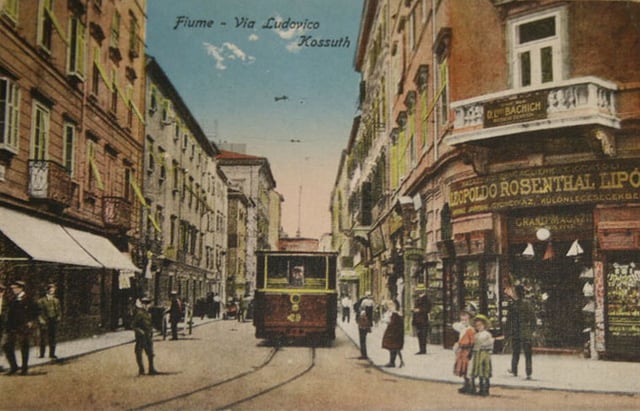
Tram in Rijeka
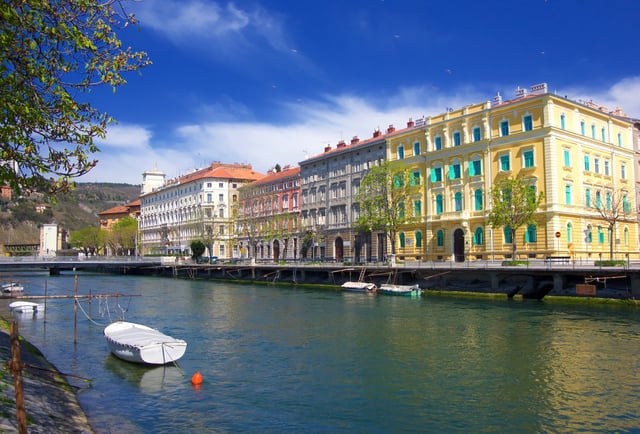
River Rječina in city center
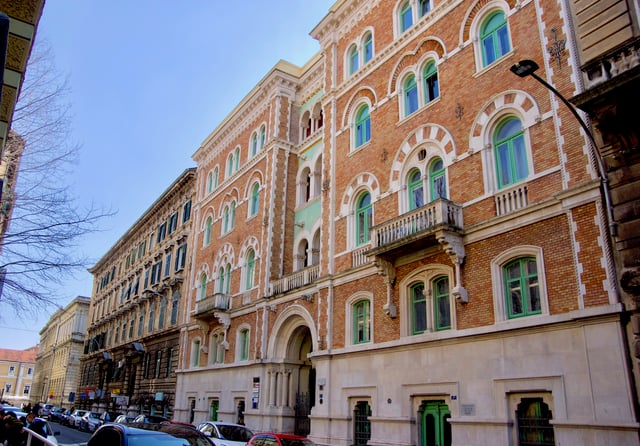
Casa Veneziana in Rijeka
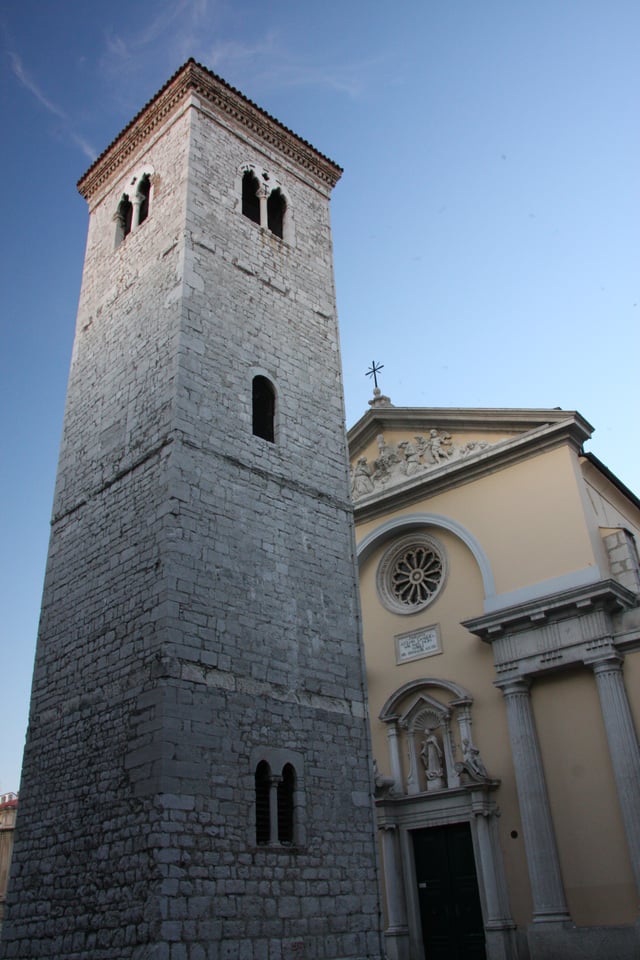
Leaning Tower
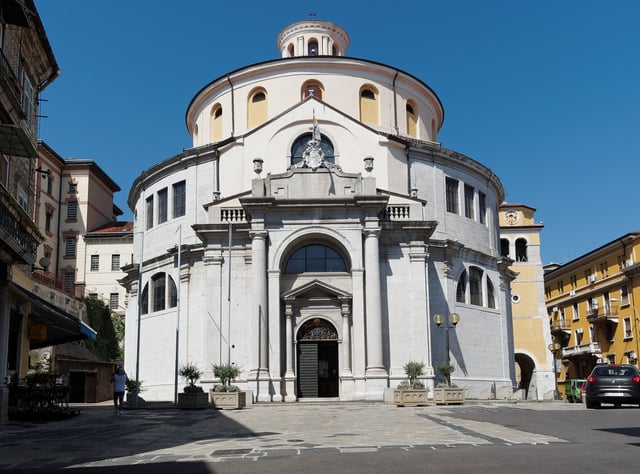
Saint Vitus cathedral
After coming under Habsburg rule in 1466, the town was attacked and plundered by Venetian forces in 1509. While Ottoman forces attacked the town several times, they never occupied it. From the 16th century onwards, Rijeka was largely rebuilt in its present Renaissance and Baroque style. Emperor Charles VI declared the Port of Rijeka a free port (together with the Port of Trieste) in 1719 and had the trade route to Vienna expanded in 1725.
By order of Empress Maria Theresa in 1779, the city was annexed to the Kingdom of Hungary and governed as corpus separatum directly from Budapest by an appointed governor, as Hungary's only international port. From 1804, Rijeka was part of the Austrian Empire (Kingdom of Croatia-Slavonia after the Compromise of 1867), in the Croatia-Slavonia province.[10]
In the early 19th century, the prominent economical and cultural leader of the city was Andrija Ljudevit Adamić. Fiume also had a significant naval base, and in the mid-19th century it became the site of the Austro-Hungarian Naval Academy (K.u.K. Marine-Akademie), where the Austro-Hungarian Navy trained its officers.
Giovanni de Ciotta (mayor from 1872 to 1896) proved to be an authoritative local political leader. Under his leadership, an impressive phase of expansion of the city started, marked by major port development, fuelled by the general expansion of international trade and the city's connection (1873) to the Austro-Hungarian railway network. Modern industrial and commercial enterprises such as the Royal Hungarian Sea Navigation Company "Adria", and the paper mill, situated in the Rječina canyon, producing cigarette paper sold around the world, became trademarks of the city.
The second half of the 19th century and the beginning of the 20th century (up to World War I) was a period of rapid economic growth and technological dynamism for Rijeka. The industrial development of the city included the first industrial scale oil refinery in Europe in 1882[11] and the first torpedo factory in the world in 1866, after Robert Whitehead, manager of the "Stabilimento Tecnico Fiumano" (an Austrian engineering company engaged in providing engines for the Austro-Hungarian Navy), designed and successfully tested the world's first torpedo.
Rijeka also became a pioneering centre for high-speed photography. The Austrian physicist Peter Salcher working in Rijeka's Austro-Hungarian Marine Academy took the first photograph of a bullet flying at supersonic speed in 1886, devising a technique that was later used by Ernst Mach in his studies of supersonic motion.[12]
Rijeka's port underwent tremendous development fuelled by generous Hungarian investments, becoming the main maritime outlet for Hungary and the eastern part of the Austro-Hungarian Empire, the fifth port in the Mediterranean, after Marseilles, Genoa, Naples and Trieste. The population grew rapidly from only 21,000 in 1880 to 50,000 in 1910. Major civic buildings constructed at this time include the Governor's Palace, designed by the Hungarian architect Alajos Hauszmann. There was an ongoing competition between Rijeka and Trieste, the main maritime outlet for Austria – reflecting the rivalry between the two components of the Dual Monarchy. The Austro-Hungarian Navy sought to keep the balance by ordering new warships from the shipyards of both cities.
Apart from the rapid economic growth, the period encompassing the second half of the 19th century and up to World War I also saw a shift in the ethnic composition of the city. The Kingdom of Hungary, which administered the city during that period, favoured the Hungarian element in the city and encouraged immigration from all lands of the Austro-Hungarian Empire. In this period the city became a melting pot encompassing most of the main ethnicities and cultures in empire, being also a main departure port for emigration to the New World. The mixed ethnic composition would open the doors to the controversial "Fiume's Question" in the years following World War I and the demise of the Habsburg Empire. At the last Austro-Hungarian census in 1911, the corpus separatum had a population of 49,608 people and was composed of the following linguistic communities:[13]
The "Fiume Question" and the Italian-Yugoslav dispute

Residents of Fiume cheering D'Annunzio and his Legionari, September 1919. At the time, Fiume had 22,283 Italians (46.9% of the total population of 49,608 inhabitants).[13]
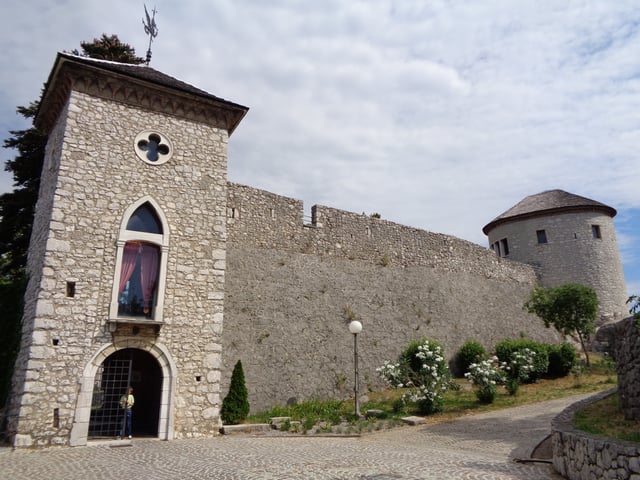
Trsat castle, south

10 Fiume krone provisional banknote (1920)
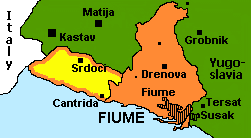
Location of the Free State of Fiume (1920–1924)
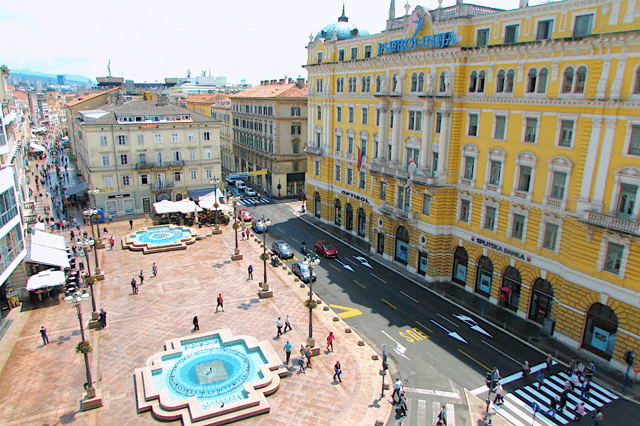
Adriatic Square and Adria Palace
Habsburg-ruled Austria-Hungary's disintegration in October 1918 during the closing weeks of World War I led to the establishment of rival Croatian-Serbian and Italian administrations in the city; both Italy and the founders of the new Kingdom of the Serbs, Croats and Slovenes (later the Kingdom of Yugoslavia) claimed sovereignty based on their "irredentist" ("unredeemed") ethnic populations.
After a brief military occupation by the Kingdom of Serbs Croats and Slovenes, followed by the unilateral annexation of the former Corpus Separatum by Belgrade, an international force of British, Italian, French and American troops entered the city in November 1918. Its future came under discussion at the Paris Peace Conference during the course of 1919.[14]
Italy based its claim on the fact that Italians comprised the largest single nationality within the city (46.9% of the total population). Croats made up most of the remainder and were a majority in the surrounding area[13]Andrea Ossoinack, who had been the last delegate from Fiume to the Hungarian Parliament, was admitted to the conference as a representative of Fiume, and essentially supported the Italian claims. Nevertheless, at this point the city had had for years a strong and very active Autonomist Party seeking a special independent status among nations for the multicultural Adriatic city, and which also had its delegates at the Paris peace conference, Ruggero Gotthardi.
The Regency of Carnaro
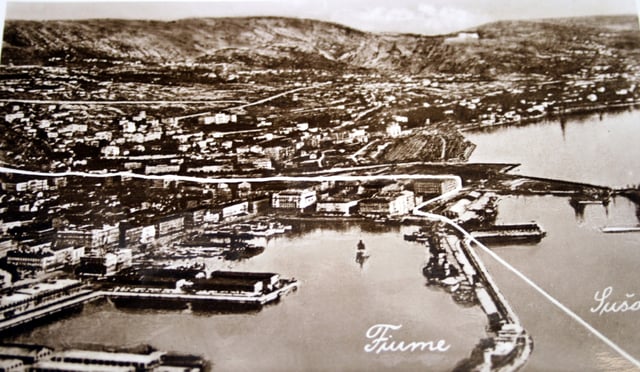
Fiueme (Rijeka) in 1937
On 10 September 1919, the Treaty of Saint-Germain was signed, declaring the Austro-Hungarian monarchy dissolved. Negotiations over the future of the city were interrupted two days later when a force of Italian nationalist irregulars led by the poet Gabriele d'Annunzio seized control of the city without casualties and wholeheartedly acclaimed by a part of the population.[15] Because the Italian government, wishing to respect its international obligations, did not want to annex Fiume, d'Annunzio and the intellectuals at his side eventually established an independent state, the Italian Regency of Carnaro, a unique social experiment for the age and a revolutionary cultural experience in which various international intellectuals of diverse walks of life took part (like Osbert Sitwell, Arturo Toscanini, Henry Furst, Filippo Tommaso Marinetti, Harukichi Shimoi, Guglielmo Marconi, Alceste De Ambris, Léon Kochnitzky, Whitney Warren).[16]
Among the many political experiments that took place during this experience, d'Annunzio and his men undertook a first attempt to establish a movement of non-aligned nations in the so-called League of Fiume, an organisation antithetic to the Wilsonian League of Nations, which it saw as a means of perpetuating a corrupt and imperialist status quo. The organisation was aiming primarily at helping all oppressed nationalities in their struggle for political dignity and recognition, establishing links with many movements on various continents, but it never found the necessary external support and its main legacy remains today the Regency of Carnaro's recognition of Soviet Russia, the first state in the world to have done so.[17][18][19]
The Liberal Giovanni Giolitti became Premier of Italy again in June 1920; this signalled a hardening of official attitudes to d'Annunzio's coup. On 12 November, Italy and Yugoslavia concluded the Treaty of Rapallo, which envisaged Fiume becoming an independent state, the Free State of Fiume, under a government acceptable to both powers.[20] d'Annunzio's response was characteristically flamboyant and of doubtful judgment: his declaration of war against Italy invited the bombardment by Italian royal forces which led to his surrender of the city at the end of the year, after five days' resistance (known as Bloody Christmas). Italian troops freed the city from d'Annunzio's militias in the last days of December 1920.
The Free State of Fiume

Capuchin Church of Our Lady of Lourdes
In a subsequent democratic election the Fiuman electorate on 24 April 1921 approved the idea of a free state of Fiume-Rijeka with a Fiuman-Italo-Yugoslav consortium ownership structure for the port, giving an overwhelming victory to the independentist candidates of the Autonomist Party. Fiume became consequently a full-fledged member of the League of Nations and the ensuing election of Rijeka's first president, Riccardo Zanella, was met with official recognition and greetings from all major powers and countries worldwide. Despite many positive developments leading to the establishment of the new state's structures, the subsequent formation of a constituent assembly for the state did not put an end to strife within the city. A brief Italian nationalist seizure of power ended with the intervention of an Italian royal commissioner, and another short-lived peace was interrupted by a local Fascist putsch in March 1922 which ended with a third Italian intervention to restore the previous order. Seven months later the Kingdom of Italy itself fell under Fascist rule and Fiume's fate was therefore set, the Italian Fascist Party being among the strongest proponents of the annexation of Fiume to Italy. The Free State of Fiume thus was to officially become the first country victim of fascist expansionism.
This period of diplomatic acrimony closed with the bilateral Treaty of Rome (27 January 1924), signed by Italy and Yugoslavia. With it the two neighbouring countries were agreeing on invading and partitioning the territory of the small state. Most of the territory of the old Corpus Separatum became part of Italy, while a few northern villages of Croatian-Slovenian language were annexed by Yugoslavia.[21] The annexation happened de facto on 16 March 1924, and it inaugurated circa twenty years of Italian government for the city proper.
The territory of Fiume part of the Kingdom of Italy
With the Treaty of Rome (27 January 1924) between the Kingdom of Italy and the Kingdom of Yugoslavia, the two countries agreed to annex and split the territory of the Free State of Fiume between themselves.[21] The formal annexation (16 March 1924) inaugurated 19 years of Italian fascist rule and the city became the seat of the newly formed Province of Carnaro. In this period Fiume lost its commercial hinterland and thus part of its economic potential, due to it becoming a border town with little strategic importance for the Kingdom of Italy. But thanks to it retaining the Free Port status, and its iconic image in the fascist nation-building myth it gained many specific concessions from the government in Rome, a separate tax treatment from the rest of the Kingdom and a more humble than in Hungarian times, but continuous inflow of investments from the state. This could still not avoid a substantial slowing of the economic and demographic growth compared to the previous Austro-Hungarian period.
During World War II and the German Operational Zone
At the beginning of World War II Rijeka immediately found itself in an awkward position. The city was overwhelmingly Italian, but its immediate surroundings and the city of Sušak, just across the Rječina river (today a part of Rijeka proper) were inhabited almost exclusively by Croatians and part of a potentially hostile power – Yugoslavia. Once the Axis powers invaded Yugoslavia in April 1941, the Croatian areas surrounding the city were occupied by the Italian military, setting the stage for an intense and bloody insurgency which would last until the end of the war. Partisan activity included guerrilla-style attacks on isolated positions or supply columns, sabotage and killings of civilians believed to be connected to the Italian and (later) German authorities. This, in turn, was met by stiff reprisals from the Italian and German military. On 14 July 1942, in reprisal for the killing of 4 civilians of Italian origin by the Partisans, the Italian military killed 100 men from the suburban village of Podhum, resettling the remaining 800 people to concentration camps.[22]
After the surrender of Italy to the Allies in September 1943, Rijeka and the surrounding territories were occupied by Germany, becoming part of the Adriatic Littoral Zone. The partisan activity continued and intensified. On 30 April 1944, in the nearby village of Lipa, German troops killed 263 civilians in reprisal for the killing of several soldiers during a partisan attack.[23]
Because of its industries (oil refinery, torpedo factory, shipyards) and its port facilities, the city was also a target of more than 30 Anglo-American air attacks,[24] which caused widespread destruction and hundreds of civilian deaths. Some of the heaviest bombardments happened on 12 January 1944 (attack on the refinery, part of the Oil Campaign),[25] on 3–6 November 1944, when a series of attacks resulted in at least 125 deaths and between 15 and 25 February 1945 (200 dead, 300 wounded).[26]
The area of Rijeka was heavily fortified even before World War II (the remains of these fortifications can be seen today on the city outskirts). This was the fortified border between Italy and Yugoslavia which, at that time, cut across the city area and its surroundings. As Yugoslav troops approached the city in April 1945, one of the fiercest and largest battles in this area of Europe ensued. The 27,000 German and additional Italian troops fought tenaciously from behind these fortifications (renamed "Ingridstellung" – Ingrid Line – by the Germans). Under the command of the German general Ludwig Kübler they inflicted thousands of casualties on the attacking Yugoslav partisans, which were forced to charge uphill against well-fortified positions to the north and east of the city. Ultimately the Germans were forced to retreat. Before leaving the city, in an act of wanton destruction (World War II was almost over), the German troops destroyed the harbour area and other infrastructure with a number of big explosive charges. However, the German attempt to break out of the partisan encirclement north-west of the city was unsuccessful. Of the approximately 27,000 German and other troops retreating from the city, 11,000 were killed (many were executed after surrendering), while the remaining 16,000 were taken prisoner. Yugoslav troops entered Rijeka on 3 May 1945.[27][28] The city had suffered extensive damage in the war. The economic infrastructure was almost completely destroyed, and of the 5400 buildings in the city at the time, 2890 (53%) were either completely destroyed or heavily damaged.[29]
Aftermath of World War II

The Governor's Palace, Maritime and History Museum of the Croatian Littoral
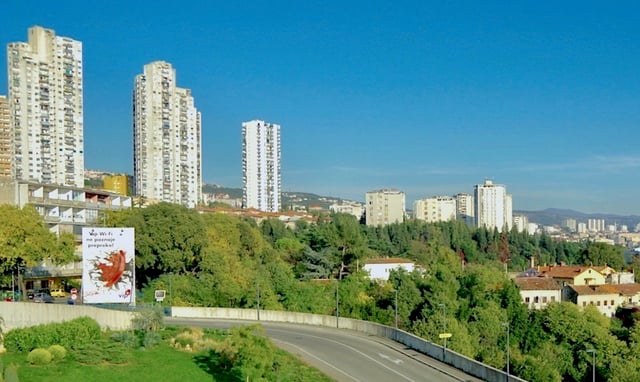
Highest residential skyscrapers in Croatia
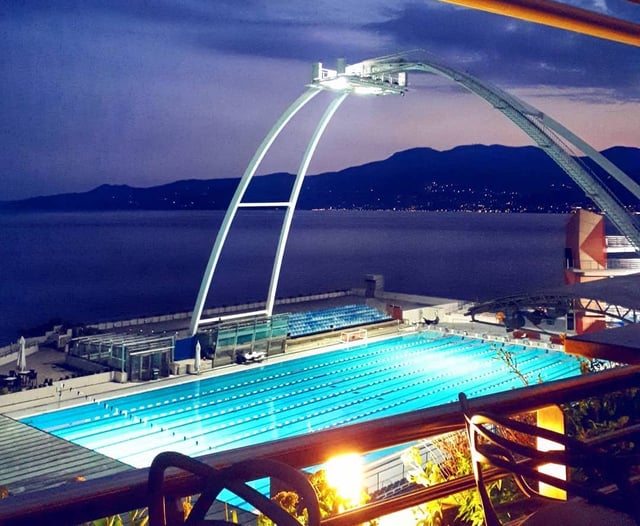
Swimming pool complex in Kantrida
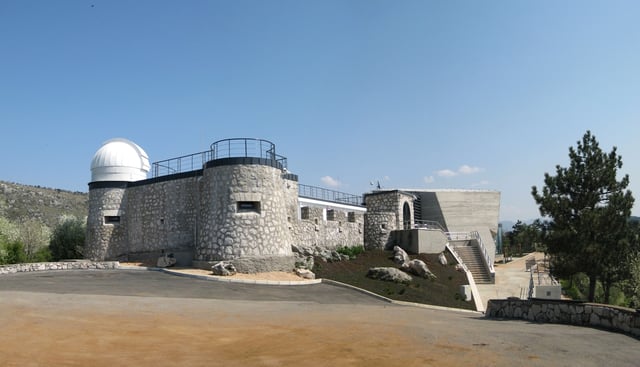
Astronomical Centre Rijeka
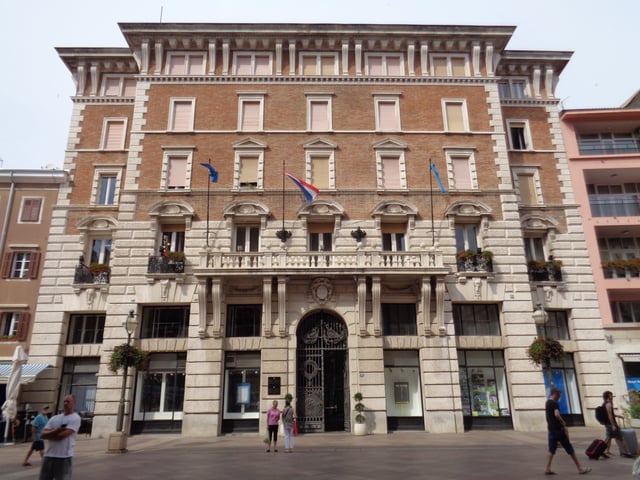
City government building
The city's fate was again resolved by a combination of force and diplomacy. Despite the requests of the Fiuman government in exile and the initial promises of large autonomy for the city by the Yugoslav authorities (up to it becoming a Federal Republic of Yugoslavia), the city became part of Yugoslavia (within the federal state of Croatia). The situation was formalised by the Paris peace treaty between Italy and the wartime Allies on 10 February 1947, despite the protests of the last democratically elected government and its president in exile Riccardo Zanella, and the attempts by experienced Italian foreign minister Carlo Sforza to uphold the previous Wilsonian plans for a Free State solution, with a local headquarter for the newly created United Nations. Once the change to Yugoslav sovereignty was formalised, and in particular in the years leading to the Trieste Crisis of 1954, 58,000 of the 66,000 Italian speakers were gradually pushed to either emigrate (they became known in Italian as esuli or the exiled ones from Istria, Fiume and Dalmatia) or endure a harsh oppression by the new Yugoslav communist regime during the first decades of its existence. The Yugoslav communist party opted for Stalinist approach in solving the local ethnic question in particular after the Autonomist-sympathisers gained massive support in the first local elections held on the city's territory after the war.
The discrimination and persecution many inhabitants experienced at the hands of the Yugoslav officials in the last days of World War II and the first years of peace still remain painful memories for the esuli and somewhat of a taboo topic for Rijeka's political milieu, which is still largely denying the events.[30] Summary executions of alleged fascists (often well-known anti-fascists or openly apolitical), aimed at hitting the local intellectual class, the Autonomists, Italian public servants, military officials and even ordinary civilians (at least 650 executions of Italians took place after the end of the war[31]) forced most ethnic Italians to leave Rijeka/Fiume in order to avoid becoming victims of harsher retaliation. The removal was a meticulously planned operation, aimed at convincing the hardly assimilable Italian part of the autochthonous population to leave the country, as testified decades later by representatives of the Yugoslav leadership.[32]
The most notable victims of the political and ethnic repression of locals in this period has been the Fiume Autonomists purge hitting the autonomists still living in the city, and now associated in the Liburnian Autonomist Movement. They actively helped the Yugoslav partisans in liberating the region from Fascist and Nazi occupation, and despite receiving various promises of large autonomy for Fiume inside the Federal Republic of Yugoslavia, they were eventually killed by the Yugoslav secret police OZNA in the days leading to and following the Yugoslav army's victorious march into city. In the subsequent years the Yugoslav authorities joined the municipalities of Fiume and Sušak and after 1954 less than one third of the original population of the now united municipalities (mostly what was previously the Croat minority) remained in the city. Thus the old municipality of Fiume lost in these years more than 85% of the original population. The city was then resettled by immigrants from various parts of Yugoslavia, changing heavily the city's demographics and its linguistic structure. These years coincided also with a period of reconstruction and new industrialisation. During the period of the Yugoslav communist administration in the 1950s–1980s the city became the main port of the Federal Republic and started to grow once again both demographically and economically thanks to the fact it got once again a solid hinterland, as well as the refurbishing of its traditional manufacturing industries after the war, its maritime economy and its port, now the largest in the country. This paired with its rich commercial history allowed the city to become the second richest (GDP per capita) district of Yugoslavia. Many of these industries were a product of a socialist planned economy paired with the unique Yugoslav cooperative model, and they have not been able to survive the move to a new economic model during the transition to a full market-oriented model in the early 1990s, due to mismanagement and many national and local cases of corruption linked to the rushed privatization process that was carried out in the newly created Republic of Croatia.
As Yugoslavia broke apart in 1991, the federal state of Croatia became independent during the Croatian War of Independence. Since then, the city has stagnated economically and its demography has plunged. Some of its largest industries and employers went out of business (among the most prominent the Jugolinija shipping company, the torpedo factory, the paper mill and many other medium or small manufacturing and commercial companies, often in the midst of big corruption scandals and a badly planned privatization). Others are struggling to stay economically viable (like the city's landmark 3. Maj shipyards). The number of workers in productive activities passed from more than 80,000 to only 5,000 within two decades. A difficult and uncertain transition of the city's economy away from manufacturing and towards the service and tourism industries is still in progress. In 2020 Rijeka will be the European Capital of Culture alongside Galway,[33] in 2018 it was announced that, 65 years after the abolishment of Italian as the official language of the city, new Croatian-Italian bilingual signs will be placed back in the Fiume's part of the modern municipality.[34]
Rijeka's International Carnival
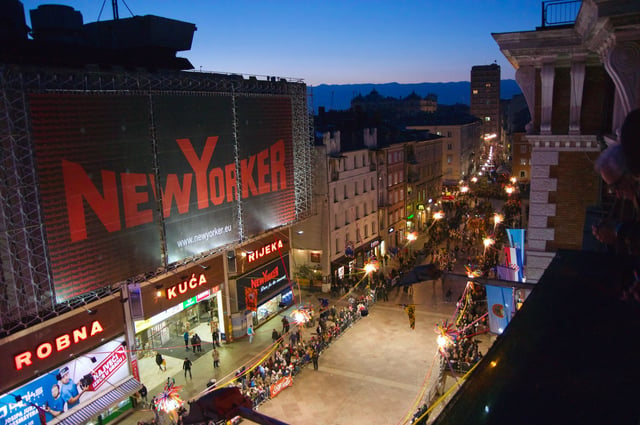
Rijeka Carnival
The Rijeka Carnival Croatian: Riječki karneval) is held each year before Lent (between late January and early March) in Rijeka, Croatia. Established in 1982, it has become the biggest carnival in Croatia. Every year there are numerous events preceding the carnival itself. First the mayor of Rijeka gives the symbolic key of the city to Meštar Toni, who is "the maestro" of the carnival, and he becomes the mayor of the city during the carnival, although this is only figuratively. Same day, there is an election of the carnival queen. As all the cities around Rijeka have their own events during the carnival time, Queen and Meštar Toni are attending most of them.
Also, every year the Carnival charity ball is held in the Governor's palace in Rijeka. It is attended by politicians, people from sport and media life, as well as a number of ambassadors.
The weekend before the main event there are two other events held. One is Rally Paris – Bakar (after the Dakar rally). The start is a part of Rijeka called Paris after the restaurant located there, and the end is in city of Bakar, located about 20 kilometres (12 miles) south east. All of the participants of the rally wear masks, and the cars are mostly modified old cars. The other event is the children's carnival, held, like the main one, on Rijeka's main walkway Korzo. The groups that participate are mostly from kindergartens and elementary schools, including groups from other parts of Croatia and neighboring countries. In 1982 there were only three masked groups on Rijeka's main walkway Korzo. In recent years, the international carnival has attracted around 15,000 participants from all over the world organized in over 200 carnival groups, with crowds of over 100,000.[35]
Demographics
| Historical populations of the City of Rijeka | ||
|---|---|---|
| Year | Pop. | ±% |
| 1880 | 37,904 | — |
| 1890 | 48,959 | +29.2% |
| 1900 | 61,419 | +25.4% |
| 1910 | 76,042 | +23.8% |
| 1921 | 61,157 | −19.6% |
| 1931 | 72,111 | +17.9% |
| 1948 | 67,088 | −7.0% |
| 1953 | 73,718 | +9.9% |
| 1961 | 98,759 | +34.0% |
| 1971 | 129,173 | +30.8% |
| 1981 | 158,226 | +22.5% |
| 1991 | 165,904 | +4.9% |
| 2001 | 144,043 | −13.2% |
| 2011 | 128,624 | −10.7% |
| Source: Naselja i stanovništvo Republike Hrvatske 1857–2001, DZS, Zagreb, 2005 | ||
In the census of 2011, the city proper had a population of 128,624, which included:[36]
Other groups, including Slovenians and Hungarians, formed less than 1% each.
The following tables list the city's population, along with the population of ex-municipality (disbanded in 1995), the urban and the metropolitan area.
| Year | City proper | Municipality | Urban | Metro |
|---|---|---|---|---|
| 2011 | 128,624 | 185,125 | 213,666 | 245,054 |
| 2001 | 144,043 | 191,647 | 220,538 | 252,933 |
| 1991 | 165,904 | 206,229 | 236,028 | 268,016 |
| 1981 | 158,226 | 193,044 | 222,318 | 251,768 |
| Population | **Area (km2)** | Density | |
| City proper | 128,624 | 44 | 2,923 |
| Ex-municipality**** | 56,501 | 473 | 119 |
| Subtotal | 185,125 | 517 | 358 |
| Urban area | 28,541 | 308 | 93 |
| Subtotal | 213,666 | 825 | 259 |
| Metro area | 31,388 | 840 | 37 |
| Total | 245,054 | 1,665 | 147 |
Ex-municipality: consists of other cities and municipalities (outside Rijeka city proper) in a former official union of adjacent settlements which was disbanded in 1995. It includes cities and municipalities of Kastav, Viškovo, Klana, Kostrena, Čavle, Jelenje, Bakar and Kraljevica.
Urban area: considered as adjacent area. It includes the ex-municipality along with cities and municipalities of Opatija, Lovran, Mošćenička Draga and Matulji, which form urban agglomeration.
Metro area: considered territory of consolidated expansion. It includes cities and municipalities of Crikvenica, Novi Vinodolski, Vinodolska, Lokve, Fužine, Delnice and Omišalj, which all gravitate to the City of Rijeka.
Panoramas
Panoramic view of Rijeka from Opatija:
Panoramic view of Rijeka and Učka:
Panoramic view of Rijeka at night:
Notable people from Rijeka
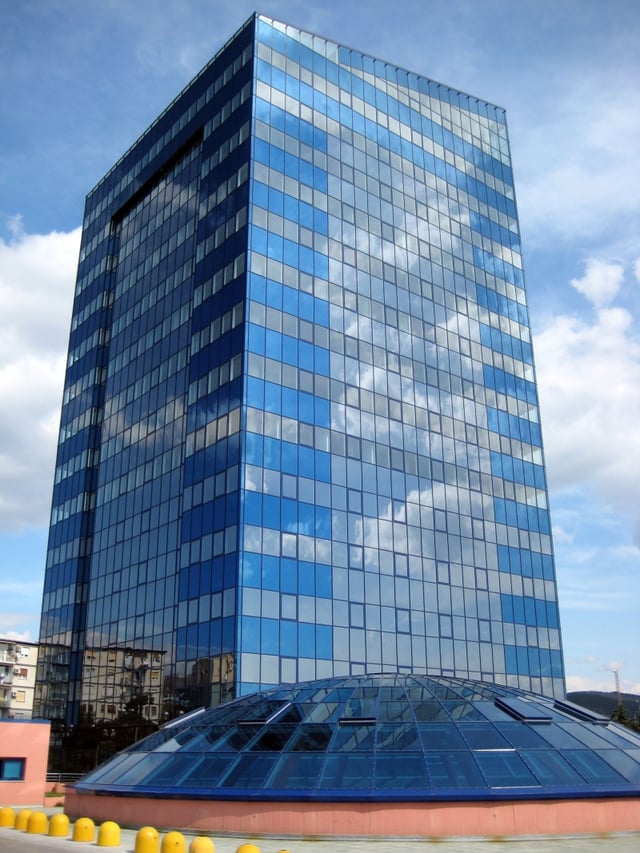
Tower centar Rijeka
Scientists, professors and inventors
Antonio Grossich, Fiuman-Italian doctor, professor of surgery and inventor of the Tincture of iodine, senator and irredentist politician
Peter Salcher, Fiuman-Austrian physicist of the Fiume Academy, pioneer of ultrafast photography and aerodynamic studies
Archduke Joseph Karl of Austria, Archduke of the Austro-Hungarian Empire, pioneering Romani language philologist and Romani Ethnograph, member of the Hungarian Academy of Sciences
Robert Ludvigovich Bartini, legendary Fiuman-Soviet aircraft designer and scientist, creator of the Bartini A-57 and Bartini Beriev VVA-14
Mihaly Csikszentmihalyi, Fiuman-Hungarian Psychology Professor at Claremont Graduate University, known as the architect of the notion of flow
Giovanni Luppis, a Fiuman (Croatian-Italian) officer of the Austro-Hungarian Navy, lead inventor of the first torpedo
Paul Felix Nemenyi, Fiuman-Hungarian mathematician and physicist
William Klinger, historian, internationally acclaimed expert of modern Croatian and Yugoslav history
Umberto D'Ancona, Fiuman-Italian Biology Professor and founder of the Hydro-biological Station in Chioggia
Arts and culture
Ödön von Horváth, Austro-Hungarian playwright, author of the famous Tales from the Vienna Woods, winner of the renowned Kleist Prize in 1931
Marija Krucifiksa Kozulić, a Catholic nun founder of the order of the Sisters of the Sacred Heart of Jesus
Oretta Fiume, Fiuman-Italian cinema star of the '30-'40s that starred in Fellini's La Dolce Vita
Janko Polić Kamov, Croatian writer and poet from Sušak
Irma Gramatica, Fiuman-Italian stage and film actress.
Geronimo Meynier, Fiuman-Italian teen film actor
Romolo Venucci, Fiuman-Italian cubist painter and sculptor
Osvaldo Ramous, Fiuman poet and writer that signed the town's 20th century literature and cultural life
Alma Selimovic, artist and LGBT activist
Politics and institutions
Riccardo Zanella, Fiuman politician, first and only elected president of the Free State of Fiume
Giovanni de Ciotta, Fiuman-Italian entrepreneur and politician, most successful mayor in the history of Fiume during the city's golden era
Michele Maylender, Fiuman politician during the Hungarian Crown's dependency, founder of the Autonomist Party of Fiume
Andrea Ossoinack, businessman and politician, having a leading role in the process of creating the Free State of Fiume, founder of the Autonomist League of Fiume
Nino Host Venturi, Fiuman-Italian fascist leader, politician and historian.
Leo Valiani, Fiuman-Italian historian, politician and journalist, dissident during the Italian fascist regime
Mario Blasich, Fiuman politician and physician, best known as a victim of the Fiume's Autonomists purge of 1945
Miklós Vásárhelyi, Hungarian dissident and writer, known for his decades long fight against the Hungarian communist party headed by János Kádár
János Kádár, Chairman of the Central Committee of the Hungarian Communist Party, served for more than 30 years as the leader of Hungary
Giovanni Palatucci, last Italian superintendent of Fiume and Righteous Among The Nations
Kolinda Grabar-Kitarović, Croatian president since 2015
Economists and entrepreneurs
Andrea Lodovico Adamich, Aristocratic trader from Fiume, builder, one of the most prominent supporters of economical and cultural development of the City
Robert Whitehead, English serial entrepreneur, known for developing the first effective self-propelled naval torpedo, in collaboration with Giovanni Luppis in Fiume.
Luigi Ossoinack, serial entrepreneur and businessman, one of the main drivers in Fiume's economic boom during the second half of the 19th century
Sportsmen
Mirza Džomba, Croatian handball player, World champion and Olympic champion
Ezio Loik, Italian footballer, member of the Grande Torino team which won 5 consecutive Serie A titles in the 1940s
Abdon Pamich, Fiuman-Italian race walker, gold medalist at the 1964 Tokyo Summer Olympics
Ulderico Sergo, Fiuman-Italian professional boxer, gold medalist at the 1936 Summer Olympics in Berlin
Orlando Sirola, Fiuman-Italian tennis player
Luciano Sušanj, Fiuman-Croatian politician, European athletic champion
Oscarre Vicich, footballer
Vladimir Vujasinović, Serbian water polo player, World and European champion, Olympic silver and bronze medalist
Musicians
Ivan Zajc, Fiuman-Croatian composer, conductor, director and teacher
Dino Ciani, Fiuman-Italian pianist
Damir Urban, Croatian musician best known for his work as a singer-songwriter for the band Laufer and for his solo work with his band "4"
Main sights
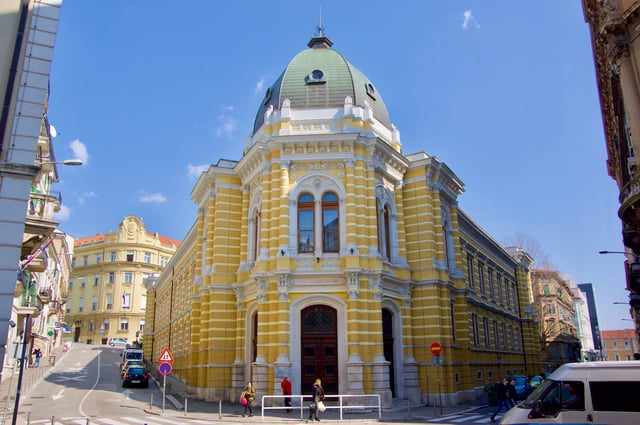
Italian high school
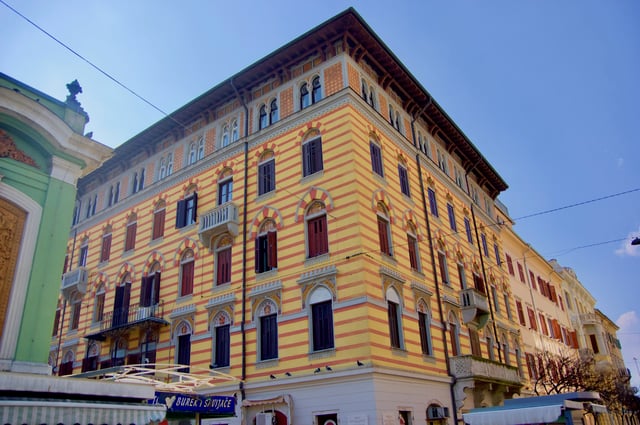
Turkish house located on the market

Palace Modello in Rijeka
Tvornica "Torpedo" (the Torpedo factory). The first European prototypes of a self-propelled torpedo, created by Giovanni Luppis, a retired naval engineer from Rijeka. The remains of this factory still exist, including a well-preserved launch ramp used for testing self-propelled torpedoes on which in 1866 the first torpedo was tested.
The Croatian National Theatre building. Officially opened in October 1885, the grand theatre building includes work by the famous Venetian sculptor August Benvenuti and ceiling artist Franz Matsch, who collaborated with Ernst and Gustav Klimt.
Svetište Majke Božje Trsatske – the Sanctuary of Our Lady of Trsat. Built 135 m (443 ft) above sea level on the Trsat hill during the late Middle Ages, it represents the Guardian of Travellers, especially seamen, who bring offerings to her so she will guard them or help them in time of trouble or illness. It is home to the Gothic sculpture of the Madonna of Slunj and to works by the Baroque painter C. Tasce.
Trsat Castle, a 13th-century fortress, which offers magnificent vistas from its bastions and ramparts, looking down the Rječina river valley to the docks and the Kvarner Gulf.
Petar Kružić staircase (or Trsat stairway), which links downtown Rijeka to Trsat. The stairway consists of 561 stone steps and was built for the pilgrims as the way to reach the Sanctuary of Our Lady of Trsat.
Old gate or Roman arch. At first it was thought that this was a Roman Triumphal Arch built by the Roman Emperor Claudius Gothicus but later it was discovered to be just a portal to the pretorium, the army command in late antiquity.
Rijeka Cathedral, dedicated to St. Vitus.
Palace Modello designed by Buro Fellner & Helmer and built in 1885.
Stadion Kantrida, was included on CNN's list of the world's most iconic and unusual football stadiums in 2011.[37]
Climate
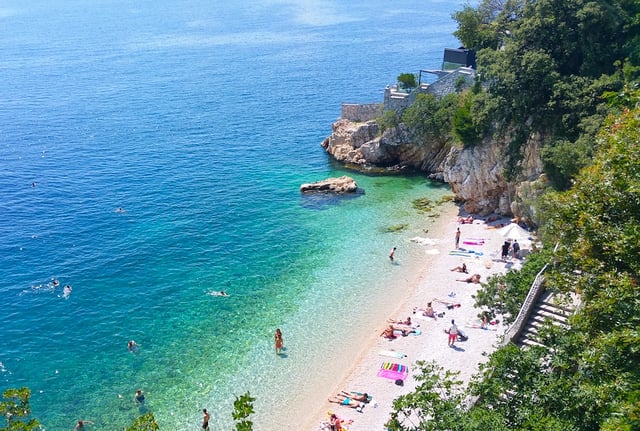
Sablićevo Beach
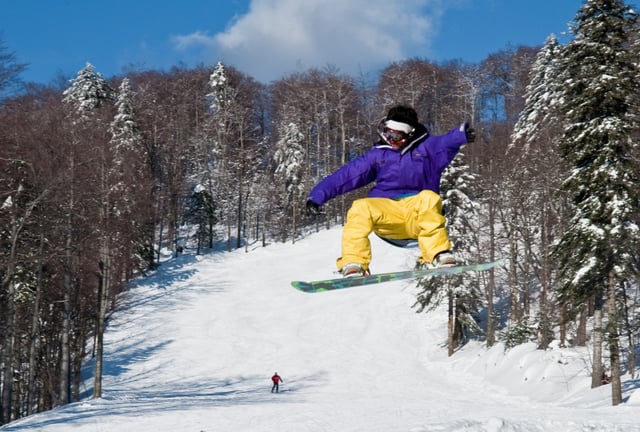
Platak ski resort, north of Rijeka
The terrain configuration, with mountains rising steeply just a few kilometres inland from the shores of the Adriatic, provides for some striking climatic and landscape contrasts within a small geographic area. Beaches can be enjoyed throughout summer in a typically Mediterranean setting along the coastal areas of the city to the east (Pećine, Kostrena) and west (Kantrida, Preluk). At the same time, the ski resort of Platak, located only about 10 kilometers (6.2 mi) from the city, offers alpine skiing and abundant snow during winter months (at times until early May). The Kvarner Bay and its islands are visible from the ski slopes.[38] Rijeka has a Humid subtropical climate with warm summers and relatively mild and rainy winters. Snow is rare (usually three days per year, almost always occurring in patches). There are 20 days a year with a maximum of 30 °C (86 °F) or higher, while on one day a year the temperature does not exceed 0 °C (32 °F).[39] Fog appears in about four days per year, mainly in winter.[39] The climate is also characterized by frequent rainfall. Cold (bora) winds are common in wintertime.
| Climate data for Rijeka (1971–2000, extremes 1948–2014) | |||||||||||||
|---|---|---|---|---|---|---|---|---|---|---|---|---|---|
| Month | Jan | Feb | Mar | Apr | May | Jun | Jul | Aug | Sep | Oct | Nov | Dec | Year |
| Record high °C (°F) | 20.0 (68.0) | 21.4 (70.5) | 24.0 (75.2) | 28.9 (84.0) | 33.7 (92.7) | 36.7 (98.1) | 40.0 (104.0) | 39.2 (102.6) | 34.8 (94.6) | 28.8 (83.8) | 25.5 (77.9) | 20.4 (68.7) | 40.0 (104.0) |
| Average high °C (°F) | 9.1 (48.4) | 9.9 (49.8) | 12.6 (54.7) | 15.9 (60.6) | 21.1 (70.0) | 24.6 (76.3) | 27.9 (82.2) | 28.1 (82.6) | 23.5 (74.3) | 18.5 (65.3) | 13.2 (55.8) | 10.1 (50.2) | 17.9 (64.2) |
| Daily mean °C (°F) | 5.8 (42.4) | 6.3 (43.3) | 8.8 (47.8) | 12.0 (53.6) | 16.8 (62.2) | 20.3 (68.5) | 23.1 (73.6) | 23.1 (73.6) | 18.8 (65.8) | 14.2 (57.6) | 9.6 (49.3) | 6.8 (44.2) | 13.8 (56.8) |
| Average low °C (°F) | 2.9 (37.2) | 3.2 (37.8) | 5.5 (41.9) | 8.4 (47.1) | 12.8 (55.0) | 16.0 (60.8) | 18.6 (65.5) | 18.6 (65.5) | 14.9 (58.8) | 10.9 (51.6) | 6.6 (43.9) | 4.0 (39.2) | 10.2 (50.4) |
| Record low °C (°F) | −11.4 (11.5) | −12.8 (9.0) | −7.7 (18.1) | −0.2 (31.6) | 2.1 (35.8) | 7.4 (45.3) | 10.4 (50.7) | 9.1 (48.4) | 4.8 (40.6) | −1.2 (29.8) | −4.5 (23.9) | −8.9 (16.0) | −12.8 (9.0) |
| Average precipitation mm (inches) | 128.7 (5.07) | 104.1 (4.10) | 113.0 (4.45) | 113.8 (4.48) | 103.3 (4.07) | 119.9 (4.72) | 70.1 (2.76) | 101.5 (4.00) | 156.5 (6.16) | 203.9 (8.03) | 181.9 (7.16) | 155.6 (6.13) | 1,552.4 (61.12) |
| Average precipitation days(≥ 0.1 mm) | 10.7 | 8.5 | 10.3 | 12.6 | 12.5 | 12.3 | 8.8 | 9.0 | 10.6 | 12.1 | 11.7 | 11.2 | 130.1 |
| Average snowy days(≥ 1.0 cm) | 0.8 | 0.3 | 0.2 | 0.0 | 0.0 | 0.0 | 0.0 | 0.0 | 0.0 | 0.0 | 0.0 | 0.1 | 1.4 |
| Average relative humidity (%) | 65.1 | 60.3 | 60.4 | 62.6 | 63.7 | 62.4 | 56.4 | 56.0 | 63.7 | 67.4 | 67.3 | 66.4 | 62.7 |
| Mean monthly sunshine hours | 111.6 | 135.6 | 155.0 | 171.0 | 232.5 | 249.0 | 297.6 | 279.0 | 201.0 | 161.2 | 111.0 | 99.2 | 2,203.7 |
| Percent possible sunshine | 41 | 50 | 47 | 47 | 57 | 61 | 71 | 71 | 58 | 51 | 42 | 40 | 55 |
| Source: Croatian Meteorological and Hydrological Service[39][40] | |||||||||||||
Transport

Rijeka international Airport
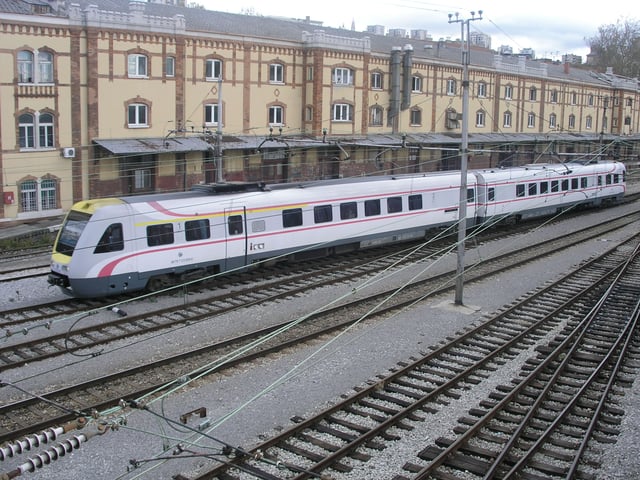
Railway in Rijeka

Ferry in Rijeka harbour
The Port of Rijeka is the largest port in Croatia, with a cargo throughput in 2017 of 12.6 million tonnes, mostly crude oil and refined petroleum products, general cargo and bulk cargo, and 260,337 Twenty-foot equivalent units (TEUs).[42] The port is managed by the Port of Rijeka Authority. The first record of a port in Rijeka date back to 1281, and in 1719, the Port of Rijeka was granted a charter as a free port. There are ferry connections between Rijeka and the surrounding islands and cities, but no direct international passenger ship connections. There are coastal lines to Split and onward to Dubrovnik, which operate twice weekly and have international connections.
The city is difficult to get to by air outside of the tourist season. The city's own international airport, Rijeka Airport is located on the nearby island of Krk across the tolled Krk Bridge. Buses, with a journey time of approximately 45 minutes, operate from Rijeka city center and nearby Opatija, with a schedule based on the planned arrival and departure times of flights. Handling 183,606 passengers in 2018, the facility is more of a charter airport than a serious transport hub, although various scheduled airlines have begun to service it with a comparatively large number of flights coming from airports in Germany. Most of these flights only operate during the tourist season between approximately May and October. Alternative nearby airports include Pula (around 90 minutes drive from Rijeka), Trieste (around 90 minutes), Ljubljana (around 2 hours), Zagreb (around 2 hours) and Venice (around 3 hours).
Rijeka has efficient road connections to other parts of Croatia and neighbouring countries. The A6 motorway connects Rijeka to Zagreb via the A1, while the A7 motorway, completed in 2004, links Rijeka with Ljubljana, Slovenia, via Ilirska Bistrica and with Trieste, Italy. The A7 acts as the Rijeka bypass motorway and facilitates access to the A8 motorway of the Istrian Y network starting with the Učka Tunnel, and linking Rijeka with Istria. As of August 2011, the bypass is being extended eastwards to the Krk Bridge area and new feeder roads are under construction.
Rijeka is integrated into the Croatian railway network and international rail lines. A fully electrified railway connects Rijeka to Zagreb and beyond towards Koprivnica and the Hungarian border as part of Pan-European corridor Vb. Rijeka is also connected to Trieste and Ljubljana by a separate electrified line that extends northwards from the city. Rijeka has direct connections by daily trains to Vienna, Munich, and Salzburg, and night trains running through Rijeka. Construction of a new high performance railway between Rijeka and Zagreb, extending to Budapest is planned, as well as rail links connecting Rijeka to the island of Krk and between Rijeka and Pula.
Sports
The history of Rijeka's organised sports started between 1885 and 1888 with the foundation of the Club Alpino Fiumano in 1885, the Young American Cycle Club in 1887 (the first club of this American league to be founded in a foreign land), and the Nautico Sport Club Quarnero in 1888 by the Hungarian minority of the city. Even earlier, in 1873, following the initiative by Robert Whitehead, the first football match to be disputed in today's Republic of Croatia territory was played in Rijeka: the Hungarian Railways team and the English engineers-led team of the Stabilimento Tecnico di Fiume (later Torpedo Factory of Fiume). The first football club in Fiume was founded under the name of Fiumei Atletikai Club.
Today, HNK Rijeka are the city's main football team. They compete in the Croatian First Football League and were the champions of Croatia in 2016–17. Until July 2015, HNK Rijeka were based at the iconic Stadion Kantrida. With Kantrida awaiting reconstruction, they are based at the newly-built Stadion Rujevica, their temporary home ground located in the club's new training camp. Additionally, HNK Orijent 1919 are based in Sušak and play in the Croatian Third Football League.
Rijeka's other notable sports clubs include RK Zamet and ŽRK Zamet (handball), VK Primorje EB (waterpolo), KK Kvarner (basketball) and ŽOK Rijeka (women's volleyball).
Rijeka hosted the 2008 European Short Course Swimming Championships. In its more than 80 years of history, LEN had never seen so many records set as the number of them set at Bazeni Kantrida (Kantrida Swimming Complex). A total of 14 European Records were set of which 10 World Records and even 7 World Best Times. This championship also presented a record in the number of participating countries. There were more than 600 top athletes, from some 50 European countries. Swimmers from 21 nations won medals and 40 of the 51 national member Federations of LEN were present in Rijeka.
International relations
Twin towns — sister cities
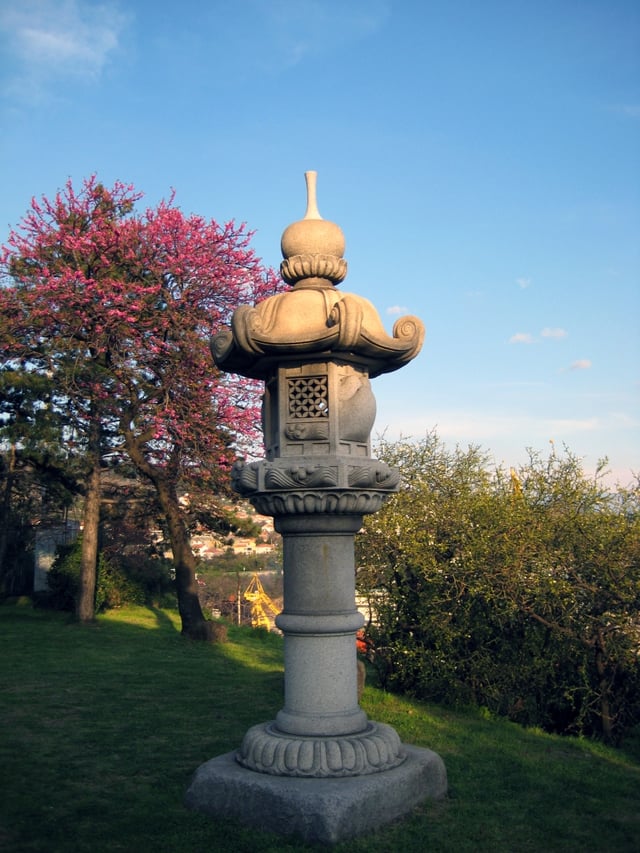
Lantern, a gift from the Japanese city Kawasaki to the city of Rijeka
Rijeka is twinned with:
In popular culture
A stylised version of Fiume during the 1920s was one of the main settings in the 1992 movie Porco Rosso by world acclaimed Japanese director Hayao Miyazaki, as the town in front of which the fantastical "Hotel Adriano" is found and to which it is connected by a boat service taken by the protagonist.[45] Bruce Sterling's November 2016 novel, written in collaboration with Warren Ellis, Pirate Utopia,[46] a dieselpunk alternative history, is set in Fiume (now Rijeka) in 1920 during the short-lived Italian Regency of Carnaro.[47] The 1980s American TV series The Winds of War was in part filmed in Rijeka and the surrounding areas.[48] The German western Winnetou movies from the 1960s, based on Karl May novels, were in part filmed on location in the outskirts of Rijeka.[49] The setting of the 1970s cartoon series Professor Balthazar was inspired by Rijeka.[50] The TV series Novine (The Paper),[51][52] which has been streaming on Netflix since April 2018, is based in Rijeka and the city was used as the main filming location.[53]
See also
Quotes about Rijeka [65]
Čavle
Charter of Carnaro was the constitution of the Italian Regency of Carnaro, a short-lived government in Fiume (Rijeka)
Crikvenica
Drenova, Rijeka
Fiume (disambiguation)
Geography of Croatia
Ilario Carposio
Kastav
Kostrena
Kvarner Gulf
List of governors and heads of state of Fiume
Primorje-Gorski Kotar County
Robert Whitehead
Rječina
Sušak
Trsat
Fužine
